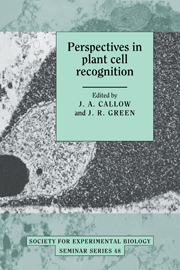Book contents
- Frontmatter
- Contents
- List of contributors
- Preface
- Sexual signalling in Chlamydomonas
- Gamete recognition and fertilisation in the fucoid algae
- The fungal surface and its role in sexual interactions
- Gamete recognition in angiosperms: model and strategy for analysis
- The molecular biology of self-incompatible responses
- Cell surface arabinogalactan proteins, arabinogalactans and plant development
- Local and systemic signalling during a plant defence response
- Contact sensing during infection by fungal pathogens
- The electrophysiology of root–zoospore interactions
- Molecular differentiation and development of the host–parasite interface in powdery mildew of pea
- Recognition signals and initiation of host responses controlling basic incompatibility between fungi and plants
- Cell surface interactions in endomycorrhizal symbiosis
- Host recognition in the Rhizobium leguminosarum–pea symbiosis
- The Rhizobium trap: root hair curling in root–nodule symbiosis
- Structure and function of Rhizobium lipopolysaccharide in relation to legume nodule development
- Index
- Plate section
Recognition signals and initiation of host responses controlling basic incompatibility between fungi and plants
Published online by Cambridge University Press: 07 May 2010
- Frontmatter
- Contents
- List of contributors
- Preface
- Sexual signalling in Chlamydomonas
- Gamete recognition and fertilisation in the fucoid algae
- The fungal surface and its role in sexual interactions
- Gamete recognition in angiosperms: model and strategy for analysis
- The molecular biology of self-incompatible responses
- Cell surface arabinogalactan proteins, arabinogalactans and plant development
- Local and systemic signalling during a plant defence response
- Contact sensing during infection by fungal pathogens
- The electrophysiology of root–zoospore interactions
- Molecular differentiation and development of the host–parasite interface in powdery mildew of pea
- Recognition signals and initiation of host responses controlling basic incompatibility between fungi and plants
- Cell surface interactions in endomycorrhizal symbiosis
- Host recognition in the Rhizobium leguminosarum–pea symbiosis
- The Rhizobium trap: root hair curling in root–nodule symbiosis
- Structure and function of Rhizobium lipopolysaccharide in relation to legume nodule development
- Index
- Plate section
Summary
Introduction
There is a basic incompatibility between higher plants and fungi at the species level, an incompatibility which is the norm in interactions between these two types of organism. Plants in general are resistant to most fungal species, even those that are pathogenic on other plants. This type of incompatibility is synonymous with non-host resistance. It is also sometimes termed ‘heterologous incompatibility’ to distinguish it from the specific incompatibility observed in homologous interactions between plants and pathogenic fungal species (Gabriel & Rolfe, 1990). In this chapter I summarise what we know about the recognition and response events which appear to be involved in this basic rejection of fungi by higher plants. The study of ‘higher’ levels of specificity (e.g. the specific incompatibility between races of some biotrophic pathogens and certain cultivars of their hosts) has perhaps attracted more attention, but it can be argued that a better understanding of basic incompatibility would enable more rapid progress to be made in understanding the mechanisms underlying successful infections (basic compatibility) and from thence the higher levels of specific resistance involved in homologous incompatibility.
Defence mechanisms controlling incompatibility
What types of mechanism operate at the level of basic incompatibility to inhibit fungal growth? Although we now seem to know much about the nature of the individual mechanisms that can operate during these interactions, there is certainly much that we do not understand. Plants have a battery of potential defence mechanisms against non-pathogens that differ from species to species, although themes are evident.
- Type
- Chapter
- Information
- Perspectives in Plant Cell Recognition , pp. 213 - 238Publisher: Cambridge University PressPrint publication year: 1992
- 4
- Cited by

